John Wolff's Web Museum
The Burroughs Adding Machine Company
Contents
|
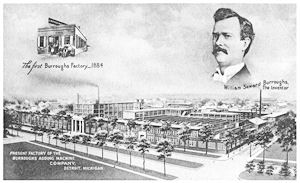
|
| Burroughs adverising postcard, c.1918 |
Overview
William Burroughs (1857-1898) built his first experimental model of
an adding machine with printed output in 1884. He formed the American
Arithmometer Company in St Louis in 1888, and commenced manufacture
in 1892. The company he founded grew to become one of the best-known
names in adding and accounting machines, but Burroughs died in 1898
without ever seeing the full success of his inventions. The company
relocated to Detroit in 1904, and was renamed The Burroughs Adding
Machine Company in 1905 in honour of its founder.
The high-keyboard adding and recording machines were the only
Burroughs products designed by William Burroughs himself. Following
his death in 1898, the product range was expanded by the (often
agressive) acquisition of potential competitors, including the Pike
adding machine and the Moon-Hopkins billing machine. Other competitors,
such as the Universal adding machine, were purchased and immediately
closed down. In 1911 Burroughs produced a key-driven calculator which
was almost identical in appearance to the established Felt & Tarrant
"Comptometer".
Burroughs lost a number of legal actions relating to these activities,
and eventually settled for producing its own products which could
compete on their merits. A very successful family of "Portable" adding
machines (the "P" series) appeared in 1925. The 20-pound weight of the
"portable" was relative to the high-keyboard machines, which weighed
well over 100 pounds in some configurations. A range of ten-key adding
and listing machines (the "J" series) was introduced in 1954, and
electronic machines in the 1960s.
The printing calculators grew into bookkeeping machines in the
1920s and 30s, automatic accounting machines during the 1940s and 50s,
and then into electronics, computers, and aerospace systems through
the 1960s and 70s. The company became the Burroughs Corporation in
1953, and merged with Sperry to form Unisys in 1986.
Burroughs had extensive overseas operations, and was exporting to
60 countries by the mid-1920s. Burroughs machines sold in Australia
prior to the 1939-45 war were built in Detroit for the British
currency system - pounds, shillings, pence, and sometimes farthings
(quarter-pence). During the European reconstruction in the late 1940s
Burroughs built a
major new factory at Strathleven in Scotland, initially to assemble
machines from US-made parts and later to manufacture the full product
range for the British and Commonwealth markets. Most of the post-war
Calculators and Portables found in Australia are from the Strathleven
factory. The 10-key J-series machines were built in France, but did not
sell in any quantity in Australia until the decimal currency conversion
in 1966.
The Burroughs Adding Machine
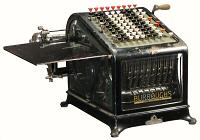 Burroughs Adding Machine, Class 1, Model 9, S/N 9-137308
Burroughs Adding Machine, Class 1, Model 9, S/N 9-137308
9 columns (10 digits), Sterling currency (with Farthings)
Dimensions: Body 9-1/2"W x 13"D x 13"H
Weight: 67 pounds
Manufactured: Burroughs Adding Machine Company, Detroit, 1910
The external appearance of the classic Burroughs adding machine
changed very little from 1892 into the 1920s. The distinguishing
features are the high sloping keyboard, the bevelled glass front, and
the printing mechanism out-of-sight at the rear of the machine. The
glass front was a necessity, as the display register is actually
inside the casing. Many machines had glass sides as well, to display
the internal mechanism and the ornate cast-iron framework.
The illustration shows a manually-operated glass-sided machine for
Sterling currency (with Farthings). The paper carriage takes rolls,
sheets, or printed forms, and has an end-of-page indicator and bell.
The carriage can be positioned manually to adjustable stops.
The machine performs addition only, with no provision for
subtraction either directly or by addition of complements. There are
two large keys on the left-hand side for totals and sub-totals, and
three smaller keys for non-add, repeat, and error (or keyboard clear).
The red buttons at the top of the machine act as zero keys to clear
the individual keyboard columns.
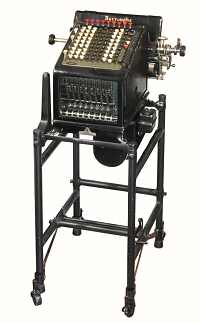 Burroughs Adding Machine, Class 1, Model 2, S/N 2-591672
Burroughs Adding Machine, Class 1, Model 2, S/N 2-591672
9 columns (10 digits), Sterling currency, electric motor drive
Dimensions: Body 9-1/2"W x 13"D x 13"H, overall 20"W x 20"D x 36"H
Weight: 120 pounds
Manufactured: Burroughs Adding Machine Company, Detroit, about 1919
This Model 2 adding machine was built in about 1919. The machine has
nine columns for Sterling currency (without Farthings), and is fitted
with a wide paper carriage and an electric motor drive. The machine is
supported on a tubular steel frame with the motor and gearbox mounted
underneath. The pillars on the left-hand side of the frame supported a
writing table which is no longer present. The frame is fitted with
four retractable castors to allow the 120-pound assembly to be moved
with safety.
The Burroughs Class 3 "Visible" Adding Machine
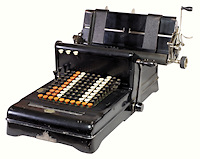 Burroughs Visible Adding Machine, Class 3, S/N 3-564358
Burroughs Visible Adding Machine, Class 3, S/N 3-564358
10 columns, Sterling currency
Dimensions: Body 10-1/2"W x 19-1/2"D x 8"H, overall height 13"
Weight: 52 pounds
Manufactured: Burroughs Adding Machine Company, Detroit, 1919
The Burroughs Class 3 machine is based on the mechanism designed by
William H Pike Jr for his Pike Adding Machine Company. Pike appears
to have worked previously for William Burroughs in St Louis, as his
name appears as inventor on American Arithmometer Company patents from
1897. Pike left St Louis around 1901 and established the Pike Adding
Machine Company in Orange, New Jersey. Production commenced in 1904,
and was well established when the company was acquired by Burroughs
in 1909. When Burroughs relocated the manufacturing operations to
Detroit, the Pike factory in Orange was acquired by the newly-formed
Monroe calculating machine company.
The Pike machine was smaller, simpler, and cheaper than the
Burroughs, but its biggest advantage was visible printing. The printed
results were in full view of the operator, rather than hidden at the
back of the machine. Burroughs continued to develop the machine into
the 1920s, adding features such as two-colour and split printing, wide
paper carriages, direct subtraction, and electric motor drive. The
machine was sometimes known as the "flat-bed" after the long horizontal
arrangement of the keyboard and the display register. The Class 3
machines were discontinued in favour of the new Burroughs "Portable"
in the late 1920s.
The example illustrated is a large 10-column machine for bookkeeping
work in Sterling currency. The
keyboard
allows the leftmost three columns to be used for date printing, via the
two small control levers at the front and left. The machine has a wide
movable carriage with adjustable tabulator stops. A lever at the right
releases the carriage and allows it to be pushed by hand to stop at the
next printing position. The long lever on the upper right provides a
rapid form eject function. A fixed tally-roll holder is located behind
the carriage.
Class 3 keyboard detail.
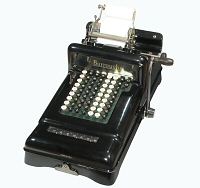 Burroughs Visible Adding Machine, Class 3, S/N 3-989895
Burroughs Visible Adding Machine, Class 3, S/N 3-989895
7 columns, Sterling currency
Dimensions: 9-1/2"W x 19-1/2"D x 8"H
Weight: 40 pounds
Manufactured: Burroughs Adding Machine Company, Detroit, 1925
This smaller Class 3 machine from 1925 is a basic 7-column adder
for Sterling currency, with a fixed paper-roll printing mechanism.
It is missing the keytops for the Non-add, Non-print, and Repeat keys.
The Burroughs Calculator
The "Burroughs Calculator" was a non-printing key-driven machine
introduced in 1912 in response to the success of the Felt & Tarrant
"Comptometer". It was sometimes known as the "Horton calculator"
after its designer, Allen A. Horton. It was also widely known as the
"Burroughs comptometer", in spite of Felt & Tarrant's strenuous efforts
to protect their
trademark.
The first Burroughs key-driven machine was very similar to the
Comptometer in its external appearance, but was quite different in its
internal mechanism, with the register and carry mechanism based on a
complex system of planetary gears. It was only about two-thirds of the
weight of the Felt & Tarrant machine, and had none of the safety
features. In particular, there was no protection against incomplete
keystrokes in either direction. The register would simply advance in
proportion to the depth of stroke, with no indication of error.
However, the price was also about two-thirds of the Comptometer, which
made it quite a popular (if dangerous) machine.
Horton and his associate Walter J. Pasinski continued to develop
the key-driven calculator over a long period. A machine with an
electric motor drive was produced in 1928, and an electric machine
with a grand-total register in 1933. The patent records suggest that
Pasinski was still actively involved with the machine into the 1950s.
An excellent article contributed by a former Burroughs operator
can be found on the
Comptometer Operators pages.
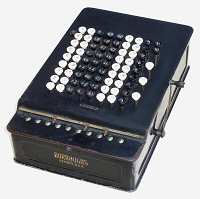 Burroughs Calculator, S/N 205077
Burroughs Calculator, S/N 205077
9 columns (10 digits), Sterling currency
Dimensions: 9-1/4"W x 14-1/2"D x 6"H
Weight: 13-1/2 pounds
Manufactured: Burroughs Adding Machine Company, Detroit, 1911-14
A very early 9-column Burroughs Calculator for Sterling currency,
in a black pressed-metal case.
Although the case shows a remarkable similarity to the Felt &
Tarrant Comptometer, the Burroughs
keyboard differs in a number of areas. The ten-shillings column has a
full row of "1" keys, while the 10 and 11 pence keys are shifted
sideways into the farthings column. There is no key release button,
as the machine does not have the mis-operation locking mechanism.
There are no subtraction cutoff levers, so it is necessary for the
operator to left-fill a complement entry with 9s. A small un-labelled
key in the top left corner enters a 9 into the leftmost column.
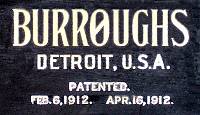 This transfer on the rear panel of Burroughs Calculator No. 205077
shows the original US Patent dates in 1912. The corresponding patent
numbers are 1016501 and 1023168, issued to Allen A Horton and
Walter J Pasinski respectively. The Horton patent is for the machine
as a whole, while Pasinski's covers improvements to the design of
the tens-carry mechanism.
This transfer on the rear panel of Burroughs Calculator No. 205077
shows the original US Patent dates in 1912. The corresponding patent
numbers are 1016501 and 1023168, issued to Allen A Horton and
Walter J Pasinski respectively. The Horton patent is for the machine
as a whole, while Pasinski's covers improvements to the design of
the tens-carry mechanism.
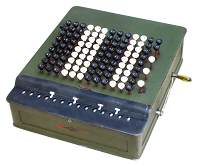 Burroughs Calculator, S/N 209714
Burroughs Calculator, S/N 209714
13 columns (14 digits), Sterling currency
Dimensions: 12"W x 14-1/2"D x 6"H
Weight: 18 pounds
Manufactured: Detroit, USA, 1911-14
This 13-column Burroughs Calculator was originally from the Post
Office in Antwerp, a once-prosperous wheat-farming town in western
Victoria. The Post Office (and most of the town) no longer exists.
The green paint and the transfer on the front are from "Macdougalls
Pty Ltd", who were once a major firm of stationers and office
suppliers in the Australian capital cities.
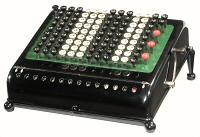 Burroughs Calculator, Class 5, S/N E5-1118781
Burroughs Calculator, Class 5, S/N E5-1118781
13 columns (14 digits), Sterling currency
Dimensions: 12"W x 11"D x 7"H
Weight: 15 pounds
Manufactured: Detroit, USA, 1915-
In spite of the differences in the keyboard and the internal
mechanism, the obvious external similarity between the original
Burroughs Calculator and the Comptometer inevitably led to litigation
over patent infringements. After some adverse findings, the Burroughs
machine was re-designed to become the Class 5 Calculator. The keyboard
mechanism is about 3" shorter than previously, although the register
mechanism is largely unchanged. The machine is housed in a rather
elegant die-cast alloy casing. The legs at the rear raise the
keyboard to an angle of about 15° and give the machine its
distinctive "high-heeled" appearance.
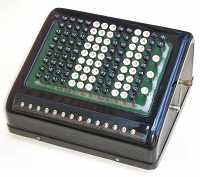 Burroughs Calculator, S/N A589671
Burroughs Calculator, S/N A589671
13 columns (14 digits), Sterling currency, converted to decimal
Dimensions: 13-1/2"W x 12"D x 8"H
Weight: 17-1/2 pounds
Manufactured: Detroit, USA, 1930s
A later Burroughs Calculator for Sterling currency, in a more
rounded pressed-metal housing. The mechanism is raised internally
to bring the keyboard to a 20° angle.
When Australia changed from Sterling to decimal currency in 1966,
this 13-column machine was "converted" very easily. The shillings and
pence columns were simply ignored, and the keytops on the nine decimal
columns were re-arranged into colour groupings for dollars and cents.
(Compare this machine to the normal Sterling keyboard on the model
below). The converted machine continued in service for another ten
years.
When key-driven machines were finally retired in favour of
electronic data processing systems in the 1970s, many of the young
girls who had trained as operators in the 1940s and 50s found
themselves and their machines "surplus to requirements". This well-used
and well-kept machine was presented to its operator as a souvenir on
her retirement. She was obviously quite attached to her former career,
as she kept the machine with its dust cover, conversion tables, and
her original training notebook for a further 20 years, only parting
with them when moving house after her husband's death in 1999.
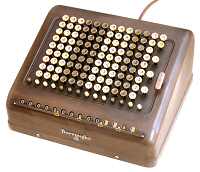 Burroughs Calculator, Electric, S/N B44195
Burroughs Calculator, Electric, S/N B44195
13 columns (14 digits), Sterling currency
Dimensions: 13-1/2"W x 12"D x 8"H
Weight: 26pounds
Manufactured: Burroughs Adding Machine Ltd, Strathleven, Scotland, c.1950
A 13-column Burroughs Calculator for Sterling currency with an
internal electric motor drive, built in the new (post-war) Burroughs
factory in Scotland. Apart from the colour scheme, the case of this
British-made machine is much the same as the manually-operated
model above. The motor provides the energy to operate the mechanism,
in a similar fashion to an electric typewriter, giving a very light
touch to the keyboard and finally eliminating the risk of partial
keystrokes. The drive mechanism was designed by Walter Pasinski in
1928, and received US Patent 1909714 in 1933.
This machine is fitted with subtraction buttons (in front of the
rows of keys), and a clearing key that is marked (incorrectly)
with a "+" sign. Otherwise, the operation is essentially the same as
the manual models.
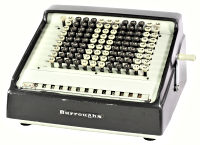 Burroughs Calculator, manual, S/N C 66655 S
Burroughs Calculator, manual, S/N C 66655 S
12 columns (13 digits), decimal currency
Dimensions: 13-1/2"W x 12-1/2"D x 8"H
Weight: 20 pounds
Manufactured: Burroughs Machines Ltd, Strathleven, Scotland, 1960s
The Burroughs Calculator was re-styled around 1960 with a larger
and more angular die-cast alloy cover. The colour scheme returned to
the original "black and white", but with a light-coloured keyplate.
There were no significant changes to the mechanism.
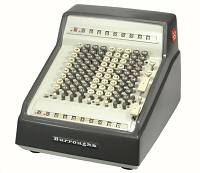 Burroughs Calculator, electric, dual register, S/N C 74328 S
Burroughs Calculator, electric, dual register, S/N C 74328 S
9 columns (10 digits), decimal currency
Dimensions: 11"W x 14-1/2"D x 10"H
Weight: 27 pounds
Manufactured: Burroughs Machines Ltd, Strathleven, Scotland, 1950s
A late-model Burroughs Calculator with an electric motor drive and
a grand-total register at the rear. The machine has a pressed-metal
base and a die-cast alloy cover.
The mechanism to drive the rear-mounted register was designed by
Walter Pasinski in 1933 (US Patents 2240797/8). Rather than advancing
both registers together, the machine accumulates a result on the
front register alone. When this calculation is complete, the operator
presses the Plus or Minus keys on the right-hand side to transfer the
result either positively or negatively to the rear register.
The Burroughs "Portable" Adding Machine
The Burroughs "Portable" adding and listing machine was designed in
the mid-1920s as a replacement for the high-keyboard machines. The
mechanism is described in US Patent 1853050 (58 pages), filed by Allen
A Horton in 1926. (Horton was also the primary designer of the
Burroughs key-driven calculator from 1912).
The Portable mechanism is a very early example of modular design as
applied to a calculating machine. Most prior machines (and a great many
subsequent ones) were designed on the "monolithic" principle - they
were assembled piece by piece "from the ground up", to perform a
specific function. Horton's Portable was designed as a set of
self-contained modules or functional blocks which could be quickly
and easily assembled in various combinations to construct a range
of machines with different characteristics.
The main module of the Portable contains just the basic operating
and control mechanisms, the actuating racks and stop bars, and the
type carriers. The accumulator and carry mechanisms are in a separate
module which attaches to the rear of the main unit with 4 screws.
Horton's original patent describes accumulator modules for addition
only, for addition and subtraction, and for duplex addition on two
independent accumulators. Modules with complementary (or "tumbler")
accumulators, true negative totals, and several multi-accumulator
arrangements for accounting machines were added later. None of the
carry mechanisms require "blank strokes" at any stage of their
operation. The keyboard is a self-contained module which can be
attached and removed with just two screws, while the print hammers
and the paper and ribbon systems are in three separate interchangeable
modules at the upper rear of the machine. A power module containing
a universal motor, gearbox, governor, and the complete electrical
equipment can be attached with just 2 screws and 2 connecting links.
The Portable was a very popular machine, as the modular construction
allowed it to be built (and re-built) in a huge range of combinations
- 6, 8, or 10 columns; decimal, Sterling, or other non-decimal
systems; add-only or direct subtraction, with or without true negative
totals; paper rolls or several types of wide paper carriages; manual
or electric operation; and so on. There were frequent minor changes
to the mechanisms and the casings as development and manufacture
continued well into the 1960s. The machines illustrated below are
just a small sample of the possibilities, arranged roughly in
chronological order.
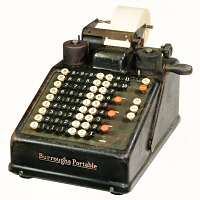 Burroughs Portable Adding Machine, Class 8, S/N 8-1359565
Burroughs Portable Adding Machine, Class 8, S/N 8-1359565
8 columns, add only, manual, Sterling currency (with Farthings)
Dimensions: 230W x 340D x 210H
Weight: 8.74kg
Manufactured: Burroughs Adding Machine Company, Detroit, c.1930
An early Class 8 (addition-only) machine from around 1930, for
Sterling currency with Farthings. The function keys in the rightmost
column are Sub-Total, Total, Non-Add, Repeat, and Error (or keyboard
clear). A small "Non-print" lever above the function keys disables the
printing and paper feed mechanisms when a printed record is not
required. Printing must, of course, be re-enabled to obtain the total,
as the Portable has no direct register display. The machine has a
flat-sided pressed-metal casing in gloss black, with the "Burroughs
Portable" name in gold on the front. (Unfortunately, the machine
illustrated also has a liberal coating of rust).
The
internal view of an early add-only mechanism shows the keyboard
stop bars, the actuating racks pivoted near the centre, and the type
carriers above. The interchangeable rear section contains the
accumulator gearset (just visible at the bottom front of the square
cutout) and the tens-carry levers at the bottom rear. The accumulator
moves forward and back to engage alternately with the racks and the
carry mechanism. The forked lever extending from the top plate operates
the paper and ribbon feed mechanisms, which are mounted on the outside
of the casing. The Portable contains 8 large springs to power the
return stroke, and a hydraulic damper to control the speed of
operation. A worn damper can leak a lot of oil if the machine is
stored or transported on its side.
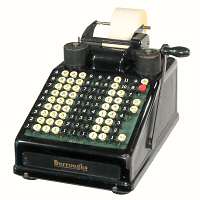 Burroughs Portable Adding Machine, Class 8, S/N 8A-187302
Burroughs Portable Adding Machine, Class 8, S/N 8A-187302
10 columns, add only, manual, Sterling currency
Dimensions: 230W x 340D x 210H
Weight: 9.12kg
Manufactured: Burroughs Adding Machine Company, Detroit, 1930s-40s
A 10-column add-only machine for Sterling currency, without
Farthings.
This later machine has a number of minor changes, including a longer
operating handle, a cover over the paper feed pawls, and deletion of
the Non-print lever. The main panels have been recessed slightly and
overpainted with a satin finish so as to give an attractive framed
appearance. The "Portable" has been deleted from the name on the front.
Take care when cleaning these machines, as the finish on the recessed
panels is badly affected by water.
The Sterling keyboard has an unusual arrangement in order to
accommodate 10 columns in the same body as the 8-column machine above.
The 10 and 11 pence keys have been moved to the top of the shillings
column, while the 8 and 9 shillings have replaced two of the redundant
1 keys at the top of the ten-shillings column.
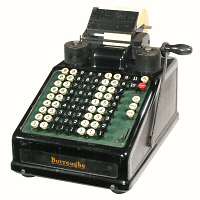 Burroughs Portable Adding Machine, Class 9, S/N 9A-209223
Burroughs Portable Adding Machine, Class 9, S/N 9A-209223
8 columns, add/subtract, manual, Sterling currency
Dimensions: 230W x 340D x 230H
Weight: 9.44kg
Manufactured: Burroughs Adding Machine Company, Detroit, c.1930
The Class 9 Portable from 1928 provides direct subtraction, but
prints complements rather than true values for negative totals. The
machine is switched manually between addition and subtraction
by means of a bare metal lever protruding from the bottom right of the
keyboard. A subtraction key was not introduced until the mid-1930s.
The printing mechanism includes a back-rest to allow annotations to be
written on the paper tape. The function keys are the same as on the
machines above.
 Burroughs Portable Adding Machine, S/N A-666699
Burroughs Portable Adding Machine, S/N A-666699
8 columns, add/subtract, electric, Sterling currency
Dimensions: 230W x 340D x 230H
Weight: 13.13kg
Manufactured: Burroughs Adding Machine Company, Detroit, 1930s-40s
Although the internal electric drive mechanism was shown in Horton's
1926 patent, the motorised machines were not available commercially
until about 1930. The drive mechanism is a self-contained unit mounted
in the previously empty space on the left of the machine. It is
controlled by an "Add bar" mounted through the top edge of the casing,
to the right of the keyboard. In the mid-1930s the subtraction lever
(shown on the machine above) was replaced with a "Subtract bar" on the
electric machines, or an additional function key on the manual models.
The Error key was moved to the bottom right of the keyboard. The Repeat
key was sometimes coupled to the Add bar on the electric machines, and
some later models had a separate Negative Repeat key next to the
Subtract bar. Some electric models could also be operated manually by
fitting a modified operating handle through the small hinged cover on
the right-hand side.
This 8-column motor-driven adder and subtractor for Sterling
currency was built in Detroit in 1947 (dated on the motor supression
capacitor). The mechanism uses a "tumbler" or complementary accumulator
for subtraction, but does not provide true negative totals. The paper
and ribbon modules have been updated to provide easier loading.
The
internal view (taken from the rear of the machine) shows the large
universal motor coupled to a cast aluminium reduction gearbox, with the
centrifugal governor and electrical switchgear at the front. The entire
drive unit attaches to the side of the machine with just 2 screws and a
couple of connecting links. The interchangeable rear section of the
machine contains the complementary accumulators and the bi-directional
tens-carry mechanism.
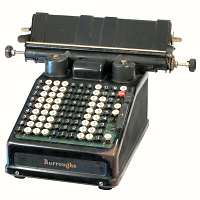 Burroughs Portable Adding Machine, S/N A 317254
Burroughs Portable Adding Machine, S/N A 317254
10 columns, add/subtract, electric, wide carriage, Sterling currency
Dimensions: Body 230W x 340D x 200H, overall 430W x 410D x 260H
Weight: 15.0kg
Manufactured: Burroughs Adding Machine Company, Detroit, 1930s-40s
A ten-column Burroughs Portable from the late 1930s, with direct
subtraction, electric motor drive, and a wide paper carriage. The
carriage can be positioned manually to adjustable tab stops, and can
be used with rolls, sheets, or printed forms. Machines such as this
formed the beginning of a long and successful line of bookkeeping and
accounting machines which eventually led Burroughs into the computer
business.
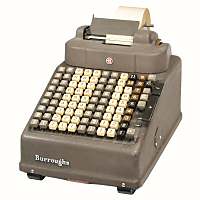 Burroughs Portable Adding Machine, S/N P 16753 S
Burroughs Portable Adding Machine, S/N P 16753 S
10 columns, add/subtract, electric, Sterling currency
Dimensions: 230W x 340D x 230H
Weight: 13.26kg
Manufactured: Burroughs Adding Machine Ltd, Strathleven, Scotland, c.1947
The Portable was "modernised" in the late 1940s with square plastic
keytops and a clip-on one-piece cover over the type bars and ribbon
spools. The case reverted to the original flat-sided version with a
dark brown textured finish. There is a cast-metal "Burroughs" badge on
the front, and the new "circle-B" logo (which was adopted in 1947) on
the ribbon cover. The very solid and formal appearance was well suited
to Burroughs' traditional banking customers.
The machine illustrated is a motor-driven 10-column adder and
subtractor for Sterling currency (without Farthings). This machine
was assembled in 1947 from US-made parts at the
new Burroughs
factory at Strathleven in Scotland.
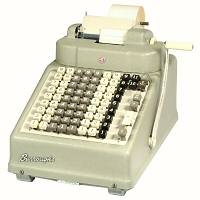 Burroughs Portable Adding Machine, S/N P 76341 S
Burroughs Portable Adding Machine, S/N P 76341 S
8 columns, add/subtract, manual, Sterling currency
Dimensions: 230W x 340D x 230H
Weight: 9.83kg
Manufactured: Burroughs Adding Machine Ltd, Strathleven, Scotland, 1950s
As the Portable's market expanded in the post-war years, the colour
scheme gradually changed from stuffy dark brown to lighter greys and
even pastel colours, with a much less formal script badge on the front
panel. The machine illustrated is manually-operated 8-column adder and
subtractor finished in a pale grey-green, with keys in mid-grey, cream,
and black.
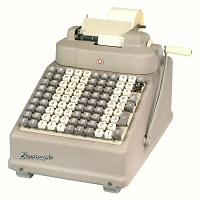 Burroughs Portable Adding Machine, S/N P 135550 S
Burroughs Portable Adding Machine, S/N P 135550 S
10 columns, add/subtract, manual, decimal currency
Dimensions: 230W x 340D x 230H
Weight: 10.1kg
Manufactured: Burroughs Adding Machine Ltd, Strathleven, Scotland, 1950s
A 10-column manual adder and subtractor for decimal currency. This
machine is finished in a light grey-brown, with grey and white keys.
It is not known whether this machine was factory-built for decimal
currency or (more probably) converted by Buroughs at the time of
Australia's decimal conversion in 1966.
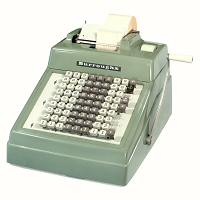 Burroughs Portable Adding Machine, S/N P 377642 S
Burroughs Portable Adding Machine, S/N P 377642 S
8 columns, add only, manual, decimal currency
Dimensions: 260W x 360D x 230H
Weight: 8.53kg
Manufactured: Burroughs Machines Ltd, Strathleven, Scotland, 1960s
A late-model add-only machine for decimal currency, which looks
positively jolly in its coloured plastic casing. The mechanism
is basically identical to the 1930s Class 8 machines above.
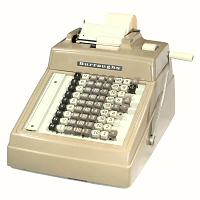 Burroughs Portable Adding Machine, S/N P 429403 S
Burroughs Portable Adding Machine, S/N P 429403 S
7 columns, add only, manual, decimal currency
Dimensions: 260W x 360D x 230H
Weight: 8.41kg
Manufactured: Burroughs Machines Ltd, Strathleven, Scotland, 1960s
This manually-operated add-only machine would originally have been
mounted on a cash drawer in a retail store. The machine has six decimal
columns with the keytops numbered in cash-register fashion. The symbol
keys in the leftmost column print leters A to E, H, CH, RA, and PO.
A channel to the left of the keyboard holds a paper strip to provide a
legend for the symbols. A linkage through the right-hand rear of the
base unlocks the cash drawer when the machine is operated.
The Burroughs Ten-key Adding and Listing Machines
The "J" series of ten-key adding and listing machines was first
introduced in 1954, but did not sell in any quantity in Australia
until the decimal currency conversion in 1966.
The mechanism is based on a conventional pin carriage and sliding
racks, and is powered by a universal (brush-type) motor. The machines
found in Australia were manufactured by the Burroughs factories in
France and Brazil.
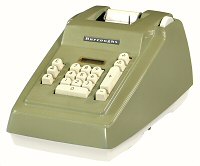 Burroughs Ten-key, Model J524, S/N J 240929 F
Burroughs Ten-key, Model J524, S/N J 240929 F
10/11 columns, electric
Dimensions: 210W x 350D x 170H
Weight: 7.46kg
Manufactured: Burroughs S.A., Paris, France, 1960s
The J524 illustrated is a basic machine with add, subtract,
total, and sub-total keys on the right of the keyboard. On the left
is an "Error" or keyboard clearing key, a non-add key, and a "repeat"
key marked with an X for use in multiplication.
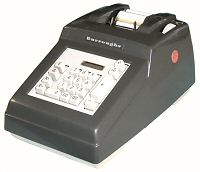 Burroughs Ten-key, Model J624, S/N J 236370 F
Burroughs Ten-key, Model J624, S/N J 236370 F
10/11 columns, electric
Dimensions: 220W x 340D x 180H
Weight: 8.0kg
Manufactured: Burroughs S.A., Paris, France, 1960s
The J624 is similar to the machine above, with the addition of a
second repeat key to enable repeated subtraction.
 Burroughs Ten-key, Model J700, S/N J 430935 F
Burroughs Ten-key, Model J700, S/N J 430935 F
10/11 columns, electric
Dimensions: 240W x 350D x 180H
Weight: 8.41kg
Manufactured: Burroughs S.A., Paris, France, 1965-
The J700 from 1965 is generally similar to the J624, but incorporates
a semi-automatic multiplier mechanism. The operator selects positive or
negative multiplication on the repeat keys (now labelled R and R-),
and then presses one of the red multiplier keys to perform the required
number of additions or subtractions. When all digits have been
processed a total is taken to print the result.
The internal mechanism is also similar to the previous model, but
with the casing an inch wider to accommodate the additional keys on
the left-hand side.
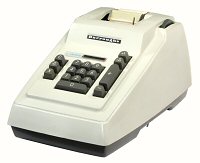 Burroughs Ten-key, 1000 Series, Model J1522, S/N J 357833 021
Burroughs Ten-key, 1000 Series, Model J1522, S/N J 357833 021
8/9 columns, electric
Dimensions: 210W x 350D x 170H
Weight: 7.57kg
Manufactured: Burroughs Eletronica LTDA, Brazil, 1960s
This "1000 Series" J1522 is similar to the J524 above, but with
only 8 places in the keyboard register and 9 in the accumulator.
The "Burroughs Electronics" nameplate confirms that Burroughs were
active in other areas of electronics in the 1960s, although this
adding machine was still entirely mechanical.
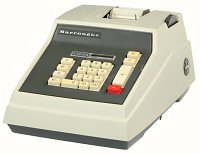 Burroughs Ten-key, 1000 Series, Model J1624, S/N J 239775 021
Burroughs Ten-key, 1000 Series, Model J1624, S/N J 239775 021
10/11 columns, electric
Dimensions: 240W x 350D x 180H
Weight: 7.85kg
Manufactured: Burroughs Eletronica LTDA, Brazil, 1960s
This 1000 Series J1624 is a later version of the J624 (above), in
a larger and more angular case. This machine was also built by the
Burroughs Electronics factory in Brazil.
The Burroughs Electronic Calculator
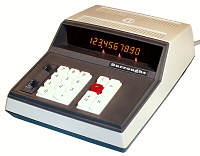 Burroughs C5000 Series, Model C5155, S/N C-164938-024
Burroughs C5000 Series, Model C5155, S/N C-164938-024
Functions: ASMD, constant
Technology: MOS-LSI (AMI, 3 chips)
Display: 10 digits, 7-segment neon (Panaplex II)
Dimensions: 200W x 285D x 100H
Weight: 2.33kg
Manufactured: S.A.Burroughs, France, 1973
This Burroughs C5155 is a basic four-function electronic calculator,
built by Burroughs in France in 1973. The circuitry uses MOS-LSI
technology in three 40-pin chips from AMI, plus a host of supporting
components.
More...
Resources for Further Information
- The book "Origin of modern calculating machines" by engineer
Joseph A.V.Turck (1921) discusses the mechanism and the development of
the early Burroughs machines in relation to the Comptometer and the
Comptograph.
- Michael Hancock's web site
provides a wealth of information about William Burroughs, and the
development of the Burroughs company and its products.
- An excellent article contributed by a former Burroughs operator
can be found on the
Comptometer Operators pages.
Original text and images Copyright © John Wolff 2002-23.
Last Updated: 1 May 2023.
Back to:
Home
Calculating Machines
Key-driven






 This transfer on the rear panel of Burroughs Calculator No. 205077
shows the original US Patent dates in 1912. The corresponding patent
numbers are 1016501 and 1023168, issued to Allen A Horton and
Walter J Pasinski respectively. The Horton patent is for the machine
as a whole, while Pasinski's covers improvements to the design of
the tens-carry mechanism.
This transfer on the rear panel of Burroughs Calculator No. 205077
shows the original US Patent dates in 1912. The corresponding patent
numbers are 1016501 and 1023168, issued to Allen A Horton and
Walter J Pasinski respectively. The Horton patent is for the machine
as a whole, while Pasinski's covers improvements to the design of
the tens-carry mechanism.





















